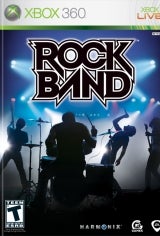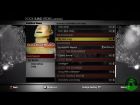The Guitar
Aesthetically, the new guitar controller created for Rock Band is a thing of beauty. Basically a 3/4-scale model of a black-and-white Fender Stratocaster, the new controller looks far more like a real guitar than a toy, with a mock maple finish for the neck and fret buttons that are barely noticeable. There's a five-way pickup switch that lets you emulate special effects like a flanger or wah-wah, and even a second set of fret buttons at the top of the neck that can be used for solos without requiring any strumming.
However, all is not well with this controller, which may actually be the game's weakest link. It would be unfair to call it "bad," as it's a pretty solid piece of hardware that most casual players will likely find adequate. But "adequate" is probably as high as the accolades go. To start, The strum bar has a squishy, imprecise feel to it, lacking the "clickiness" of previous Guitar Hero controllers, which becomes an issue when you reach the Hard or Expert difficulty levels and try to strum out faster phrases.
Additionally, the fret buttons take some getting used to. They occupy exactly the same amount of space as the GH3 Les Paul, but the buttons themselves are far bigger with almost no space between them. Look at any keyboard or gamepad or remote control and notice the extra space between the buttons; without that negative space forcing you to center your fingers on each key, you'd start accidentally mashing other buttons regularly. That's exactly what happens with the fret buttons here: it's hard to center your fingers and you're constantly slipping onto other buttons. I've made many modifications to my Guitar Hero guitars over the years, and I expect it won't be long before I take a Dremel tool to my Strat to shave the buttons into a more ergonomic shape.
Thankfully, there's an easy fix for this: go buy a copy of Guitar Hero III. The new GH3 Les Paul outshines the Strat in almost every way, which is why it's good news that Rock Band appears to be compatible with every Xbox 360 guitar controller produced to date, including the new Les Paul and older GH2 X-plorer model. Since the Rock Band bundle only comes with one guitar, you'll need a second axe anyway; might as well be the best one around. It's certainly not a cheap fix, but the reality is that without this compatibility, the Strat would be a dealbreaker for many Expert players, so the Les Paul compatibility turns out to be pretty huge.
The solo guitar campaign in Rock Band is very much structured like the Guitar Hero games. The 45 licensed songs are divided up into nine tiers of increasing difficulty, starting with easy tunes like "Say It Ain't So" and "In Bloom" before progressing to the craziness of "Run To The Hills" and "Green Grass and High Tides," the latter of which makes the solos from "Free Bird" look like a warm-up exercise.
The biggest adjustment any Guitar Hero veteran will need to make for Rock Band's guitar campaign is the new look of the notes. The square bars aren't a huge deal compared to the larger gems of the GH series, but spotting hammer-ons (consecutive notes that don't need to be strummed) is a little tougher, as they're simply a bit smaller. There's also the new energy/Overdrive system, which offers a twist on traditional GH strategy by letting you continue to collect energy when Overdrive is activated, but this is neither better nor worse than the system we're used to, just different.
The difficulty of the guitar tracks in Rock Band is probably a notch lower than what players are used to. Half of this is because the songs just aren't big shredding tunes; most would be right at home in the middle tiers of a Guitar Hero game. Songs like "Highway Star" and "Train Kept A Rollin'" offer some challenge, but the fact that they're in the guitar campaign's final tier should offer some insight to the relative difficulty of the setlist.
The other half of the equation is that the note charts are just simpler. Guitar Hero III clearly went in one direction, piling on awkward three-note chord changes in its final tiers, while Rock Band maintains note charts closer to Guitar Hero II. Several songs appear in both games -- "When You Were Young," "Cherub Rock," "Paranoid," etc. -- and while the charts are often similar, the Expert versions in Rock Band are often more forgiving than their GH3 counterparts.
Playing bass guitar in Rock Band isn't much different than guitar. In fact, there's only one difference: the ability to get a x6 score multiplier instead of x4. The bass parts are usually much easier than the lead guitar, so the extra points are a nice reward for having a solid bassist.
Overall, playing guitar in Rock Band should be a satisfying experience for anyone familiar with the Guitar Hero series. There are some minor adjustments you'll need to make, but it's more or less the same and the difficulty is nowhere near as hard as where the Guitar Hero franchise has gone, which feels somewhat appropriate for a band-focused game. The new Fender Strat is disappointing if you're looking for a precision controller, but it should be fine for casual players. Honestly, anyone who'll be that bent out of shape over it probably has a GH3 Les Paul already.





